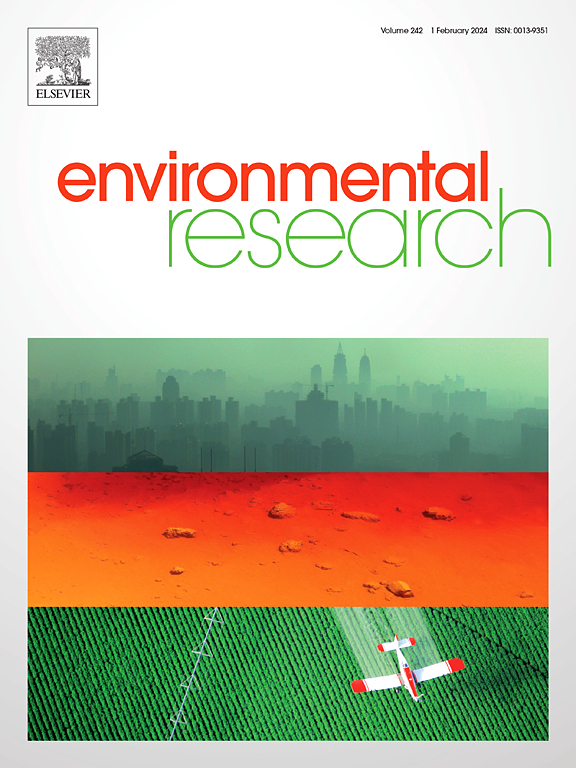Neighborhood socioeconomic disparities in cancer incidence following a hypothetical intervention to increase residential greenspace cover in the UK Biobank cohort
IF 7.7
2区 环境科学与生态学
Q1 ENVIRONMENTAL SCIENCES
引用次数: 0
Abstract
Background
Higher greenspace exposure has been associated with lower risk of certain cancers. However, few studies have evaluated potential benefits of increasing population-level exposure to greenspace on cancer disparities. We estimated the impact of a hypothetical intervention to increase residential greenspace cover on neighborhood socioeconomic disparities in total, breast, colorectal, lung, and prostate cancer incidence.
Methods
Our study included 411,787 cancer-free UK Biobank participants. Percentage of greenspace around baseline residential addresses (300m, 1000m distance buffers) was derived by combining domestic gardens and greenspace cover from the Generalized Land Use Database. We categorized neighborhood socioeconomic deprivation using the Index of Multiple Deprivation (2010). We estimated hazard ratios (HR) and 95% confidence intervals (CI) of each cancer associated with greenspace, adjusting for sociodemographic and lifestyle factors. We additionally adjusted for air pollution in supplementary analyses as we a-priori hypothesized that it was on the causal pathway between greenspace and cancer. Further, we used parametric g-computation to calculate the standardized 10-year risk of each cancer, comparing the least to most socioeconomically disadvantaged participants, both without any hypothetical greenspace intervention and under a hypothetical intervention to increase residential greenspace cover to a favorable threshold (75th percentile amongst the least socioeconomically deprived participants).
Results
We documented 40,519 incident cases of cancer over 4,210,008 person-years follow-up. An interquartile range increase in greenspace cover within 300m was associated with lower incidence of total (HR 0.98; 95% CI 0.97, 1.00) and lung (HR 0.96; 95% CI 0.92, 0.99) cancer, and was suggestively associated with lower prostate and breast cancer incidence, but not colorectal cancer. Additional adjustment for fine particulate matter air pollution (PM2.5) weakened lung cancer associations but strengthened breast and prostate cancer associations (e.g., greenspace 1000m breast cancer HR 0.94; 95% CI 0.89 0.99; 1000m prostate cancer HR 0.91; 95% CI 0.86, 0.95). The hypothetical intervention to increase greenspace (300m) resulted in 1.3 fewer total cancer cases per 1000 (95% CI 1.0, 1.6) in the most compared to least deprived group, a 23% reduction in the socioeconomic disparity gap.
Discussion
Higher residential greenspace cover was associated with lower total and lung cancer incidence, and suggestively associated with lower breast and prostate cancer incidence. Policies to increase residential greenspace cover may reduce the risk of certain cancers, particularly among socioeconomically disadvantaged groups.
在英国生物库队列中采取增加住宅绿地覆盖率的假定干预措施后,癌症发病率的邻里社会经济差异。
背景:较高的绿地暴露与较低的某些癌症风险有关。然而,很少有研究评估了增加人群绿地暴露对癌症差异的潜在益处。我们估算了增加居住区绿地覆盖率的假设干预措施对邻里社会经济差异在总癌症、乳腺癌、结直肠癌、肺癌和前列腺癌发病率方面的影响:我们的研究包括 411,787 名未患癌症的英国生物库参与者。基线住宅地址(300 米、1000 米距离缓冲区)周围的绿地百分比是通过将通用土地利用数据库(Generalised Land Use Database)中的家庭花园和绿地覆盖率结合起来得出的。我们使用 2010 年多重贫困指数对社区社会经济贫困程度进行了分类。我们估算了与绿地相关的每种癌症的危险比 (HR) 和 95% 置信区间 (CI),并对社会人口和生活方式因素进行了调整。在补充分析中,我们还对空气污染进行了调整,因为我们事先假设空气污染是绿地与癌症之间的因果关系。此外,我们还使用参数 g 计算法计算了每种癌症的标准化 10 年风险,并将社会经济条件最差的参与者与社会经济条件最差的参与者进行了比较,其中既包括未采取任何假定的绿地干预措施的参与者,也包括采取假定的干预措施将住宅绿地覆盖率提高到有利阈值(社会经济条件最差的参与者中的第 75 百分位数)的参与者:在 4,210,008 人年的跟踪调查中,我们记录了 40,519 例癌症病例。300米范围内绿地覆盖率的四分位数增加与总癌症(HR 0.98;95% CI 0.97-1.00)和肺癌(HR 0.96;95% CI 0.92-0.99)发病率的降低有关,与前列腺癌和乳腺癌发病率的降低也有提示关系,但与结直肠癌无关。对细颗粒物空气污染(PM2.5)的额外调整削弱了肺癌的相关性,但加强了乳腺癌和前列腺癌的相关性(例如,300 米前列腺癌 HR 0.93;95% CI 0.89,0.97)。增加绿地(300 米)的假定干预措施使最贫困群体与最不贫困群体相比,每千人癌症病例总数减少了 1.3 例(95% CI 1.0,1.6),社会经济差距缩小了 23%:讨论:较高的住宅绿地覆盖率与较低的癌症总发病率、乳腺癌发病率、肺癌发病率和前列腺癌发病率有关。增加居住区绿地覆盖率的政策可能会降低某些癌症的发病风险,尤其是在社会经济条件较差的群体中。
本文章由计算机程序翻译,如有差异,请以英文原文为准。
求助全文
约1分钟内获得全文
求助全文
来源期刊

Environmental Research
环境科学-公共卫生、环境卫生与职业卫生
CiteScore
12.60
自引率
8.40%
发文量
2480
审稿时长
4.7 months
期刊介绍:
The Environmental Research journal presents a broad range of interdisciplinary research, focused on addressing worldwide environmental concerns and featuring innovative findings. Our publication strives to explore relevant anthropogenic issues across various environmental sectors, showcasing practical applications in real-life settings.
 求助内容:
求助内容: 应助结果提醒方式:
应助结果提醒方式:


